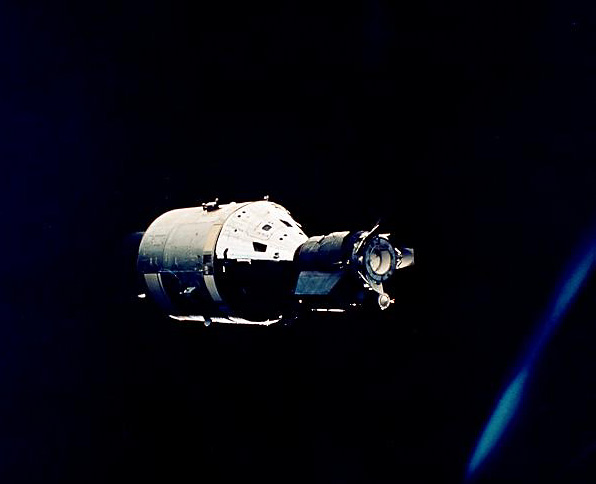| Event Category: | Launch |
| Time: | 19:50 (GMT) |
| Event: | NASA launched Apollo-ASTP (Apollo 18) from Cape Canaveral, Florida, the American half of the Apollo-Soyuz Test Project, in preparation for the unprecedented international docking of their spacecraft two days later. |
| Description: |
On 15 Juy 1975, the US and the USSR launched an Apollo spacecraft (Apollo-ASTP) and a Soyuz spacecraft (Soyuz 19), respectively, as a joint effort called the Apollo-Soyuz Test Project (ASTP), a post-Moon-race 'goodwill' flight to test a common docking system for space rescue. The Soyuz was launched first, with a two man crew who placed their spacecraft into a docking orbit. The Apollo launch 7.5 hours later followed right on schedule. Despite a stowaway - a 'super Florida mosquito' - Apollo's three man crew performed a series of rendezvous maneuvers over the next day to position their spacecraft into a proper configuration for docking with the Soyuz. The docking occurred on the third flight day, 17 July 1975. After docking, crew members rotated between the two spacecraft, with the Apollo crew first visiting the Soyuz. Stafford spent 7 hours, 10 minutes aboard Soyuz, Brand 6:30, and Slayton 1:35. The combined Apollo-Soyuz crews conducted various mainly ceremonial activities, performed joint experiments, and presented radio and TV reports. After the joint experiments were completed, the spacecraft disengaged, and each continued its separate mission.
After being docked nearly 44 hours, Apollo and Soyuz parted for the first time and were station-keeping at a range of 50 meters. The Apollo crew placed their craft between Soyuz and the Sun to create an artificial solar eclipse, as viewed from Soyuz, permitting photography of the solar corona. After the experiment, Soyuz moved toward Apollo as the active ship for the second docking.
Three hours later, Apollo and Soyuz undocked for the second and final time. The spacecraft moved to a 40 meter station keeping distance so that the ultraviolet absorption (UVA MA-059) experiment could be performed, an effort to more precisely determine the quantities of atomic oxygen and atomic nitrogen existing at such altitudes. Apollo, flying out of plane around Soyuz, projected monochromatic laser-like beams of light to retro-reflectors mounted on Soyuz. On the 150 meter phase of the experiment, light from a Soyuz port led to a misalignment of the spectrometer, but on the 500 meter pass, excellent data were received; on the 1,000 meter pass, satisfactory results were also obtained.
With all the joint flight activities completed, the ships went on their separate ways. On 20 July, the Apollo crew conducted Earth observations, experiments in the multipurpose furnace (MA-010), extreme ultraviolet surveying (MA-083), crystal growth (MA-085), and helium glow (MA-088). Apollo continued in orbit on 22-23 July to conduct 23 other independent experiments - including a doppler tracking experiment (MA-089) and geodynamics experiment (MA-128) designed to verify which of two techniques would be best suited for studying plate tectonics from Earth orbit.
After donning their space suits, the crew vented the command module tunnel and jettisoned the docking module. Apollo-ASTP landed in the Pacific Ocean near Hawaii at 21 deg 52′ N 162 deg 45′ W on 24 July 1975, 7.3 km from the recovery ship New Orleans, the last splashdown of an American space capsule. The docking module remained in orbit until it re-entered the Earth's atmosphere and burned up in August 1975.
The last flight of the Apollo spacecraft was marred by the fact that the crew almost perished while the capsule was descending under its parachute, due to the crew making a mistake during their preparations for re-entry that resulted in a very rough landing and the capsule filling with noxious fumes: The automatic landing sequence was not armed, and the reaction control system was left active. When the Apollo hadn't begun the parachute deployment sequence by 7,000 metres altitude, Brand hit the manual switches for the apex cover and the drogues. The manual deployment caused the CM to sway, and the reaction control system thrusters worked vigorously to counteract that motion. When the crew finally armed the automatic ELS 30 seconds later, the thruster action terminated. During that 30 seconds, the cabin was flooded with a mixture of toxic unignited propellants from the thrusters: Prior to drogue deployment, the cabin pressure relief valve had opened automatically, and in addition to drawing in fresh air, it also brought in the unwanted gases being expelled from the roll thrusters located about 0.6 meter from the relief valve. Brand manually deployed the main parachutes at about 2,700 meters despite the gas fumes in the cabin.
By the time of splashdown, the crew was nearly unconscious from the fumes. Stafford managed to get an oxygen mask over Brand's face who then began to come around. When the CM was upright in the water, Stafford opened the vent valve, and the in-rush of air dissipated the remaining fumes. The crew ended up with a two-week hospital stay in Honolulu. For Slayton, it also meant the discovery of a small lesion on his left lung, an exploratory operation indicated it was a non-malignant tumour.
The Apollo-Soyuz mission was the first mission carrying a handheld programmable pocket calculator, an HP-65. The calculator was programmed to perform several backup computations to partly stand in for the Apollo mission computer in case the latter should malfunction or cease to function altogether, neither of which occurred. This was the final flight of an Apollo mission. The ASTP Command Module is on display at the Kennedy Space Center, Cape Canaveral, Florida. https://nssdc.gsfc.nasa.gov/nmc/spacecraft/display.action?id=1975-066A |
| Picture: | https://nssdc.gsfc.nasa.gov/image/spacecraft/astp_apollo.jpg " "ASTP-Apollo, NASA photo Source: NSSDCA Master Catalog |
Space History Department
Resources
The L5 Development Group Home Page
The L5 Development Group Keyword Access System
Space History, July 15, 1975 /
Webmaster /
Script last modified October 17, 2004 @ 1:27 pm
Copyright © 2024 by The L5 Development Group. All rights reserved.
Hosted by FKEinternet

